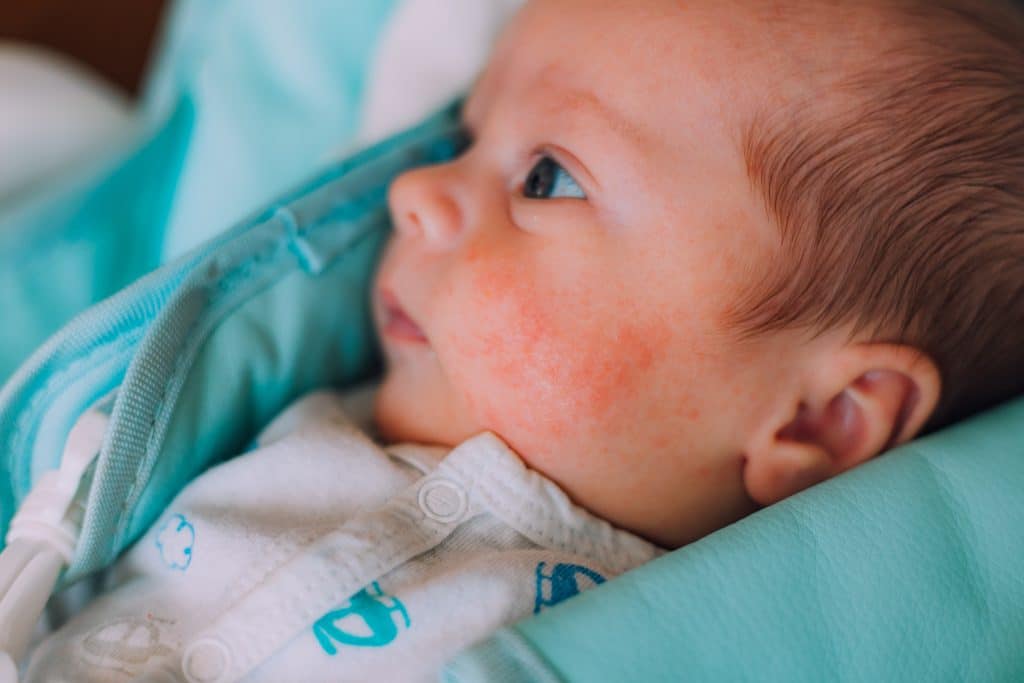The Best Atopic Eczema Treatment Creams for Babies in 2024
Atopic eczema is a common skin condition in babies, causing dryness, redness, and constant itching. Parents often search for effective solutions to ease their little one’s discomfort. This blog focuses on the benefits of using an atopic eczema treatment cream to soothe and protect sensitive baby skin, helping parents make informed treatment choices.

Understanding Atopic Eczema in Babies
Atopic eczema, commonly referred to as atopic dermatitis, is a chronic skin condition that affects many babies. It leads to inflamed, itchy, and irritated skin, causing discomfort for little ones and concern for parents. Recognising the symptoms and understanding the triggers can better equip you to manage it effectively. Here’s a closer look at what you need to know about atopic eczema in babies.
Symptoms of Atopic Eczema
Babies with atopic eczema often experience visible and sometimes distressing symptoms. Knowing what to watch for can help you address the issue early. Common symptoms include:
- Redness: Skin may appear visibly red or flushed in affected areas.
- Dryness: The skin often becomes rough and scaly due to lack of moisture.
- Itching: Persistent itching can disrupt your baby’s sleep and overall mood.
- Swelling: Inflamed areas may swell slightly, making the skin sensitive to touch.
- Skin Crusting: In severe cases, patches of skin might become crusty or ooze.
While symptoms can vary from one child to another, these are the most frequently observed. If your little one shows signs of any of these, it could be a sign of atopic eczema.
Causes and Triggers
Understanding what causes or aggravates atopic eczema can make it easier to prevent flare-ups. While the exact reason is not always clear, several factors are known to contribute:
- Genetics: A family history of eczema, asthma, or allergic conditions increases the likelihood of developing it.
- Environmental Factors: Harsh weather, low humidity, or extreme temperatures may worsen symptoms.
- Allergens: Dust mites, pet dander, and certain foods can act as eczema triggers.
- Irritants: Soaps, detergents, or fabrics like wool often irritate sensitive skin.
- Immune Response: Babies with eczema may have an overactive immune system, reacting strongly to minor irritants.
Managing these triggers involves creating a skin-friendly environment, choosing gentle skincare products, and potentially using an atopic eczema treatment cream. Such creams can help restore moisture to the skin barrier and reduce discomfort.
Being informed about both symptoms and causes can empower you to create a skincare routine tailored to your baby’s needs.
Importance of Treatment for Atopic Eczema
Atopic eczema is more than just a passing nuisance. Its impact on a baby’s skin and overall wellbeing cannot be overstated. Proper treatment goes beyond alleviating immediate symptoms—it protects your baby’s skin and sets the foundation for long-term skin health. Here’s why early intervention is vital.
Effects on Daily Life
Caring for a baby with atopic eczema involves more than keeping their skin hydrated. The discomfort of dry, red, and itchy skin can lead to disrupted sleep, irritability, and feeding difficulties. Imagine waking up every hour because your baby is restless—this quickly becomes the reality for many parents.
Untreated eczema can turn simple routines into stress-filled challenges. For instance:
- Sleep disturbances: Persistent itching makes it hard for babies to fall and stay asleep.
- Feeding interruptions: Irritability can make nursing or bottle-feeding difficult.
- Enhanced skin irritation: Activities like clothing changes or baths can exacerbate symptoms if the skin barrier is already compromised.
The condition doesn’t just affect the baby; it impacts parents, who often feel helpless watching their little one suffer. By introducing an effective atopic eczema treatment cream, you can soothe the skin and restore comfort to both the baby and the household.

Long-term Skin Health
Ignoring eczema can lead to more complex skin issues down the line. While it may seem like a temporary phase, untreated eczema in babies can result in:
- Permanent skin damage: Continuous scratching weakens the skin, increasing the chance of scarring.
- Increased risk of infections: Open sores or lesions create pathways for bacteria, leading to infections like impetigo.
- Chronic skin conditions: Severe eczema may persist into childhood and adulthood without proper skin management.
Prevention is key to maintaining healthy skin for years to come. Using a targeted atopic eczema treatment cream can help repair the skin barrier, reducing the risk of bacterial infections and long-term complications. Early and consistent care ensures your baby’s skin stays as resilient as possible.
Atopic Eczema Treatment Cream for Babies
Choosing the right eczema cream for your baby is essential to managing symptoms effectively. With sensitive baby skin, you need a product that not only soothes but also nourishes, helping to restore their delicate skin barrier.
Key Ingredients in Eczema Creams
The ingredients in an eczema cream are the foundation of its effectiveness. Recognising the role of key components makes it easier to choose the best cream for your baby. Look for creams containing:
- Snail mucin: A natural ingredient celebrated for its skin-repairing abilities.
- Moisturising agents: Ingredients like glycerin and shea butter to lock in hydration.
- Gentle compounds: Hypoallergenic and fragrance-free formulas designed specifically for sensitive skin.
Snail mucin stands out as a unique ingredient gaining popularity. It’s included in Bragan Skincare’s Atopic Eczema Treatment Cream, specifically formulated to soothe and heal baby skin.
Benefits of Snail Mucin
Snail mucin has been used for centuries to treat a range of skin concerns. Its effectiveness stems from its unique properties:
- Deep hydration: Rich in molecules like glycosaminoglycans, it holds moisture within the skin.
- Skin repair: Packed with allantoin, it promotes cell regeneration, aiding in faster recovery of irritated skin.
- Anti-inflammatory effects: Reduces redness and soothes inflamed areas, making it perfect for eczema-prone skin.
Parents often find that a cream infused with snail mucin offers substantial relief when managing eczema. For further details, you can explore the benefits as highlighted in Bragan Skincare’s formulation.
How to Apply Atopic Eczema Treatment Cream
Applying the cream correctly can significantly improve its effectiveness. Here are some practical tips:
- Apply post-bath: After a warm bath, gently pat your baby’s skin dry and immediately apply the cream. This locks in moisture.
- Target problem areas: Focus on inflamed and dry patches, ensuring a thin, even layer.
- Be consistent: Use the cream daily, or as advised by your paediatrician, to maintain hydration and skin barrier health.
- Use gentle strokes: Avoid rubbing harshly; instead, softly massage the cream until absorbed.
For a comprehensive guide, consider visiting this resource on applying eczema treatment cream effectively.
These steps ensure maximum comfort for your baby and make managing atopic eczema less stressful for you as a parent.
Choosing the Right Cream
Finding the right atopic eczema treatment cream for babies can feel overwhelming for many parents. Different creams have different benefits depending on ingredients and intended use. To ensure safety and effectiveness, it’s important to follow certain steps when choosing a cream for your baby.
Consulting a Healthcare Professional
Before trying any atopic eczema treatment cream, always consult a paediatrician. Why take risks when your baby’s sensitive skin is involved? A professional evaluation ensures the treatment aligns with your child’s specific needs. Paediatricians can recommend products that are safe, effective, and suitable for your baby’s age and skin condition.
Ignoring this step might lead to trial-and-error use of creams, possibly worsening symptoms. Professionals can also spot underlying issues that mimic or worsen eczema. If you’re considering trying a new cream, this resource on treatment creams provides valuable insights to guide your choice.
Reading Labels and Ingredients
The label on a product tells you everything you need to know—if you know how to read it. For babies with eczema, opt for creams that are:
- Fragrance-free: Perfumes can irritate sensitive skin.
- Hypoallergenic: Reduces the risk of allergic reactions.
- Dermatologist-tested: Indicates the product has been approved for skin safety.
Ingredients are key. Look for hydrating agents like glycerin and ceramides, which help lock in moisture and repair the skin barrier. Avoid potential irritants such as alcohol, parabens, or harsh chemicals. If you’re looking for where to start, this guide on eczema treatment creams breaks down safe and effective cream options.
Taking these precautions ensures the cream you select truly works to alleviate your baby’s eczema symptoms, making it easier to manage flare-ups while protecting their delicate skin barrier.

Real Experiences and Testimonials
When treating atopic eczema in babies, hearing real-life experiences from other parents can provide insight and comfort. Testimonials showcase the effectiveness of recommended products and share valuable advice on managing the condition daily.
Success Stories
Many parents have shared encouraging stories about using effective treatments for their babies. These testimonials underline the impact of choosing the right product and strategy for managing atopic eczema:
- “This cream has been a game-changer for my child’s eczema. The itching stopped almost immediately!”
- “After trying countless remedies, Bragan Skincare’s formula worked wonders for my baby. The redness vanished within days!”
Hearing such stories can inspire confidence in making informed decisions. For additional insights, you can read more about these testimonials on the Atopic Eczema Treatment Cream page.
Parental Advice
Managing eczema isn’t just about the cream—it’s about adopting a comprehensive approach to soothe your baby’s skin. Here are practical tips from experienced parents:
- Hydrate the Skin Regularly: Apply moisturiser multiple times daily to keep the skin soft and prevent dryness.
- Choose Gentle Fabrics: Stick to smooth, soft materials like cotton to reduce irritation from rough fabrics.
- Monitor Potential Allergens: Identify triggers such as perfumes, dust, or certain foods and reduce exposure.
Parents often highlight the importance of consistency in eczema care routines. Combining these strategies with a dependable treatment cream can bring relief and support long-term skin health.
Conclusion
Effectively managing atopic eczema in babies requires a consistent and informed approach. Selecting the appropriate treatment cream can significantly impact your child’s comfort and skin health.
Bragan Skincare’s formula is specially designed with sensitive baby skin in mind. By incorporating soothing and hydrating ingredients, it offers a practical solution for alleviating symptoms and protecting the skin barrier.
Invest in a thoughtful skincare routine and prioritise your little one’s wellbeing. Take the first step towards lasting relief today.
Atopic Cream for Sensitive Skin
Our atopic cream is designed to treat skin conditions, be they inherited or as a result of sensitivity to allergens such as soaps, detergents, stress and the weather. Made from snail mucin – a natural ingredient with a wealth of healing, hydrating, and anti-inflammatory properties, our Atopic Cream is dermatologically tested and effective in treating chronic skin conditions including eczema, psoriasis, and dermatitis. It brings relief to those suffering from irritated or itchy skin, rashes and allergic reactions. In addition, snail mucin reduces scar tissue and stretch marks and is soothing for dry and sensitive skin. Incorporate snail mucin cream into…
Featured Bragan Skincare Products
-
€39.99 – €100.00Price range: €39.99 through €100.00Select options This product has multiple variants. The options may be chosen on the product page
-
€100.00Select options This product has multiple variants. The options may be chosen on the product page


